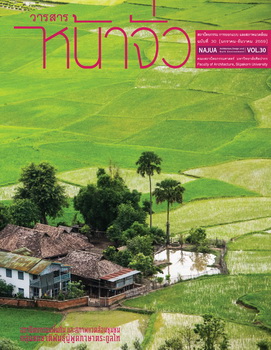การเปลี่ยนผ่านความหมายภูมิทัศน์วัฒนธรรมเมืองสกลนคร ในพุทธศตวรรษที่ 16-25
คำสำคัญ:
การเปลี่ยนผ่าน, ความหมาย, ภูมิทัศน์วัฒนธรรม, สกลนคร, Transformation, Meaning, Cultural Landscape, SakonNakhonบทคัดย่อ
การตั้งถิ่นฐานเมืองสกลนครนับตั้งแต่ยุควัฒนธรรมเขมรในช่วงพุทธศตวรรษที่16 จนถึงยุควัฒนธรรมล้านช้างในช่วงพุทธศตวรรษที่ 18-23 ส่งผลให้เกิดการซ้อนทับทางภูมิทัศน์วัฒนธรรม อันเป็นผลมาจากคติและความเชื่อทางศาสนา โดยในช่วงพุทธศตวรรษที่16-18 วัฒนธรรมเขมรได้เข้ามาครอบครองพื้นที่แถบนี้ และได้นำเอาความเชื่อในศาสนาฮินดูและพุทธนิกายมหายานเข้ามาปรับแต่งพื้นที่ โดยใช้คติเทวราชา คติมลฑลและธรรมเนียมการจัดการพื้นที่ ก่อให้เกิดรูปแบบภูมิทัศน์เมืองตามความเชื่อที่มีศาสนสถานเป็นตัวแทนของเทวบรรพตและเป็นศูนย์กลางจักรวาลตั้งอยู่บริเวณศูนย์กลางเมือง และสถาปนาขอบเขตมลฑลศักดิ์สิทธิ์ด้วยคูนํ้าและคันดินรอบย่านเมืองเก่าสกลนคร ซึ่งสื่อความหมายถึงการให้พื้นที่เมืองสกลนครเป็นพื้นที่มลฑลศักดิ์สิทธิ์ แต่ภายหลังจากวัฒนธรรมเขมรได้เสื่อมอำนาจลงในปลายพุทธศตวรรษที่ 18 พื้นที่เมืองสกลนครได้ถูกครอบครองโดยวัฒนธรรมล้านช้าง ที่นำเอาความเชื่อตามศาสนาพุทธนิกายเถรวาทเข้ามาเผยแผ่ โดยใช้กระบวนการเข้าครอบครองหรือดัดแปลงพื้นที่ศักดิ์สิทธิ์เดิม และใช้วาทกรรมผ่านตำนานเพื่อการเผยแผ่ความเชื่อในวงกว้าง โดยให้ความหมายใหม่กับพื้นที่เมืองสกลนครนั้นเป็นดินแดนชมพูทวีปตามความเชื่อในไตรภูมิคติ ซึ่งมีความหมายถึงดินแดนที่พุทธศาสนาเจริญรุ่งเรือง มีความสงบสุขและอุดมสมบูรณ์ รวมถึงการประดิษฐ์สร้างจารีต ประเพณีเพื่อการตอกยํ้าความเชื่อทั้งในระดับสามัญชนและผู้ปกครอง ส่งผลให้เกิดการเปลี่ยนแปลงทางกายภาพเมืองในรูปแบบพุทธนิกายเถรวาทที่สำคัญคือ การสร้าง ศาสนสถาน (วัด,เจดีย์) เป็นจำนวนมากถึง 12 แห่งภายในเขตเมืองเก่าตามแนวคิดและความเชื่อเรื่องชมพูทวีปที่มีพัฒนาการต่อเนื่องมาจนถึงช่วงรัตนโกสินทร์ตอนต้นในพุทธศตวรรษที่ 23-25 และปรากฏเป็นร่องรอยทางภูมิทัศน์วัฒนธรรมของเมืองสกลนครมาจวบจนปัจจุบัน
Transformation in the Cultural Landscape of SakonNakorn and its Significance from the 11th - 20th Century
Anuwat Kranthak
Doctor of Architecture Program, Faculty of Architecture, Khonkaen University
Songyot Weerataweemat
Faculty of Architecture, Khonkaen University
Evidence of settlements in SakonNakorn from the period of Khmer civilization in 11th century up to the Lao LanChang period during the 13th-18th centuries, revealed superimposed layers of cultural landscapes that were influenced by local myths and religious beliefs. During the 11th-13th centuries, the area of SakonNakorn was under the influence of Khmer culture. Hindu and Mahayana Buddhist doctrines were introduced, and the concept of Devaraja divine rulers and Cosmic Mandala were applied to architecture and site planning. Thus the image of the city had the place of worship, representing Celestial Mountain at the center of the universe, located at the center of the settlement, and the boundary of this sacred domain was defined by moats and embankments which surrounded the ancient city of SakonNakorn. This signified that SakonNakorn itself was in effect, a sacred domain, or the Cosmic Mandala. However, after the decline of Khmer civilization during the late 12th century, SakonNakorn became occupied by the Lao of LanChang. Theravada Buddhist ideologies were introduced, and former religious architecture in the Khmer style were modified according to the doctrines of the new sect. A new significance was accorded to SakonNakorn through legendary stories that turned it into a land of Jambudvipa, the southernmost continent according to Triphum (three worlds) Buddhist cosmological belief, which meant that it was a land where Buddhism flourished and full of peace and prosperity. This was also where traditions and customs were created to instill the belief into the minds of both commoners and rulers alike. Consequently, important changes to the physical form of the city under Theravada ideologies took place with the construction of up to twelve Buddhist temples within the area of the old city according to the concept of Jambudvipa. This development continued up until the Early Bangkok period in 18th-19th centuries and remains a legacy of SakonNakorn’s cultural landscape from past to present.





